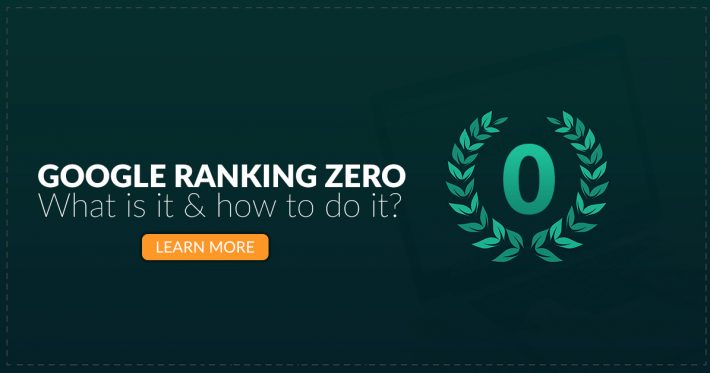
What is Google Position “0” a.k.a Featured Snippets
Google launched Featured Snippets just over two years ago, however, a lot of website owners still don’t know what they are. Or, even better, how to optimize for them. We all know that having the first spot in Google’s search results is valuable real estate.
But…what about spot #0?
Today we’re seeing more of these Featured Snippets than ever before. Still, it can be difficult to know how to actually rank for this valuable spot.
Below we hope you’ll learn everything you need to know about Google’s Featured Snippets, plus how you can increase your chances of being selected for this very valuable spot.
What Are Featured Snippets?
Featured Snippets are relatively uncharted territory by Google. Still, they seek to address an age old problem of the search engines. Most search engines started a human created directories, but when this became too much to handle they turned to algorithms to handle their dirty work.
However, this has led to things like people trying to game the search engine algorithms for their own gain and opened up the whole world of black hat SEO.
In all, the goal of Google is to provide searchers with the most relevant and helpful search results possible. So, we’ve started to notice a trend towards adding a human touch back into the search results.
This started with the introduction of the Knowledge Graph. This nice little touch would pull data from directories like Wikidata. These “cards” were factual, mostly pure information based queries, and answered very straightforward questions. They look something like this:
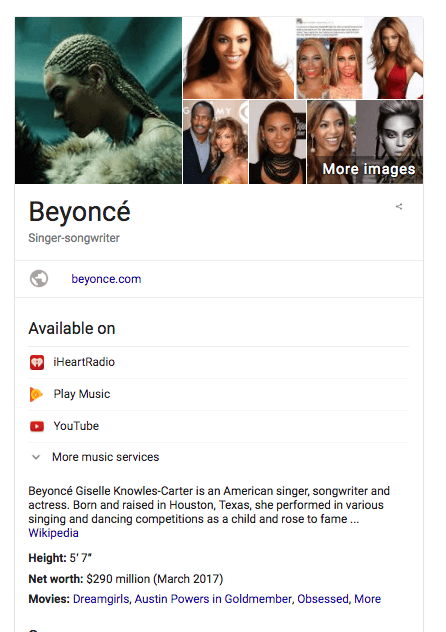
The Featured Snippet is the evolution of this and it’s much more complex than just choosing the first search result and scraping their first paragraph of text. Instead of choosing the highest ranking piece of content they’re looking for the most relevant and helpful answer.
Most Featured Snippets are focused on answering questions, however you’ll see them scattered across some general keywords as well.
There are a ton of factors involved in this, most of which aren’t entirely certain. But, we hope by the end of this you’ll be better equipped to increase the odds your post will be chosen.
Featured Snippet Types
There are currently six main types of Featured Snippets. Although Google does change the content into the desired format within the Featured Snippet box, you’ll do yourself a favor by pre-optimizing the content.
- Lists
- Images
- Tables
- Charts
- Knowledge Graph
- Text
When you’re structuring your own content you’ll want to keep the above formats in mind and choose the best format that accurately answers the question you’re optimizing for.
Why Featured Snippets Matter
It seems that Google’s consistently rolling out new algorithm updates or changes to what websites can and can’t do to rank. With all of the noise it can be difficult to determine what is and isn’t working, and what’s actually going to have a positive impact on your own business.
So, you’re probably wondering: are Featured Snippets actually important? Or, are they just another passing fad?
Here’s a few reasons you might start to believe and value the importance of Featured Snippets.
1. They Get Search Engine Spot #0
Look at the top search result for the term “how to make pancakes”.
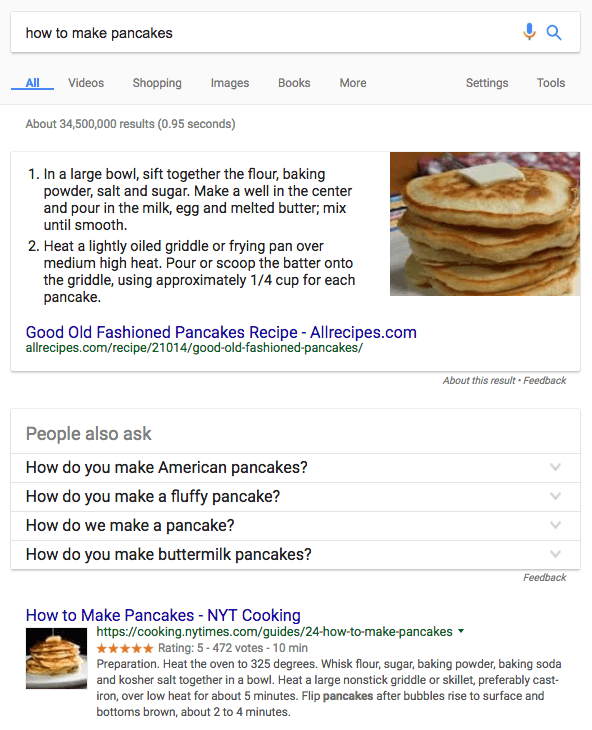
Featured Snippets come before the rest of the organic search results. Usually, nothing beats #1, but in this case, #0 is the more valuable spot to have.
Plus, you’ll notice that the first spot is pushed down even further. Especially for searches that have the ‘People also ask’ box.
The featured snippet box will also give you multiple search listings on the same page. If you already occupy the first result and the featured snippet box, then you’re getting two listing results on the same page. However, the listing that’s ranked number one doesn’t always get the featured snippet result, which we’ll get into more below.
2. Their Prevalence is Only Growing
Featured Snippets are growing and don’t show any signs of slowing down. A recent analysis by Moz found that Featured Snippets were present on about 2% of keywords from their 10,000 keyword set. By the middle of July this expanded to 11%.
We think that the test phase of Featured Snippets is over and we can expect them to blanket more and more of the search results. Of course, having Featured Snippets show up for every search result won’t happen overnight, but it would be a smart idea to begin optimizing your content to grab the snippet when they begin introducing it for your chosen keyword.
3. Their Click Through Rate Is Surprisingly High
Initial speculation of Featured Snippets was that click throughs to the highlighted site would suffer. However, most existing evidence points to the fact the Featured Snippets can actually boost your CTR in most cases.
Although most of the current evidence is anecdotal there’s reason to believe that Featured Snippets have a higher click-through rate. Back in February 2016 HubSpot conducted a study which found that ranking for a high-volume keyword at position 0 produced a CTR boost of 114%.
How to Optimize for Featured Snippet Placement
Getting Featured Snippet placement takes a lot more than just ranking in the first position in Google. Although ranking number one doesn’t hurt your chances there are still other factors at play.
According to this white paper from Get Stat websites in the number one position only accounted for 1/3 of the Featured Snippets. The bulk of the remaining snippets were populated by sites in the #2 through #5 spots. So, once you’re in the top rankings there are more important factors that will push your site into the Featured Snippet box.
You’ll notice that Featured Snippets most commonly appear for question-based search queries. Currently, you’ll notice that they do pop up for other search results, but question-based queries are still the most most common.
Below you’ll learn a few methods for better optimizing your existing content to appear in the Featured Snippet.
1. Answer the Question Explicitly
Make answering the question the focal point of your post. Although the algorithm for pulling the snippet text is still undefined, or not entirely understood, it’s a good idea to place the answer to your question as early on in the post as possible.
One good way to optimize for this is to provide short answers to the questions and concerns your post targets early on in the content, even as far as putting it right after the header that contains the question/keyword you’re optimizing for.
Make sure you provide a short and clear response that will be easy for the search engines to extract. You’re welcome to expand on that answer later, but it’s a good practice to provide something easy to digest up front.
Another good way to increase the chances of Featured Snippet selection is to do your best to align your answer with the actual searchers “intent”. If you’re unsure, or the question has multiple right answers, then provide all of them in a clear and concise format.
This is also incredibly beneficial to your readers, as they’ll be able to see what the post is about before they decide to read further.
Featured Snippet Optimization Tips:
- Include the targeted question inside your content.
- Rephrase the question before you include your answer to the question.
- Include variations of the question in your content.
2. Choose the Right Format
According to an analysis done by SEMRush the portion of snippable content you’d like to have as the Featured Snippet should fall between 40 and 50 words. However, beyond length you’ll also want to pay attention to the format of your content.
In some instances, Google will re-format your content inside the Featured Snippet box. But, generally you’ll have a better chance at being “picked” if your content is already in the right kind of format.
When you’re trying to choose the right format, come at the problem from the eyes of Google. What they’re trying to do is provide searches with the most helpful and relevant answer to their question. So, if the focus of your post is more tutorial focused, then include a simple step-by-step breakdown. If it’s more data-based, then include a simple chart. And on and on, depending upon the focus of your content.
3. Improve Engagement Metrics
Your post’s engagement metrics play a big factor in if your site will be chosen for the Featured Snippet, or not.
You can do things like improving the time spent on site, reducing your bounce rate, and improving your CTR. If all of these factors are strong this signals to Google that your piece of content is very high-quality and incredibly valuable for readers.
And since Google is looking to provide the best content to their readers, then your site is going to get the top pick. If your site is ranking, but not picking up the Featured Snippet, then focus on improving these quality indicating metrics.
4. Ranking Higher Does Help
Even though engagement metrics are very important for featured snippet placement your overall rankings still do help.
However, backlinks matter much less when you’re already on page one. A good strategy would be to focus on SEO until your site is on the first page, then spend more time maximizing your piece of content to improve your overall engagement metrics.
If you’re ranking on the first page and aren’t sure why a site is highlighted in the Featured Snippet over you, then analyze their site. Do they do a better job of answering the question? Do they format their post differently? See if you can decipher what they’re doing that you’re not.
How to Rank for More Featured Snippets
You can focus on optimizing your existing content to increase the odds of it being chosen for a Featured Snippet. But, it’s also a good idea to expand your reach too, by anticipating other questions your audience might have.
Below we show you how to find even more question-related queries to rank for, and why you should include them in older, or newer posts you create.
1. Target Longer Questions
Considering creating content that addresses complex questions. Think of these questions as being similar to long-tail keywords. Easier to rank for, more targeted, and less competition.
For instance, let’s take a question like, ‘how do I rank my website in Google?’. We could answer this in a simple sentence or two, but it wouldn’t be that valuable to anyone. It might provide a taste of what’s to come in the featured snippet box, but the searcher would be included to dig deeper and actually read your post.
Make sure you don’t target questions that can be totally answered in a single sentence. This will only make clicking through to your site unnecessary, as the searcher can find whatever information they’re looking for without visiting your site.
As you do your keyword research see if you come across any question-related keywords that you can provide an in-depth answer too.
2. Look for Related Search Queries
Are you looking for even more questions/keywords you can target for the Featured Snippets box? Don’t just stop at your initial keyword research. The options below will help you come up with even more targeted queries you can fit into existing posts, or use it as the topic of a new blog post.
-
Drop-Down Box
Let Google help you out. Whenever you’re typing a keyword into Google you’ve no doubt noticed the drop down box that includes long-tail related keywords.

All of these keywords are searches that Google thinks is related to your current search term. You can either include these related keywords within the content of your existing post, or use them to write something entirely unique.
-
Related Searches at the Bottom of the Results
At the bottom of the search results you’ll see a list of keywords that are related to the present inquiry. These related keywords are useful in that they can help you see the scope of the original keyword.
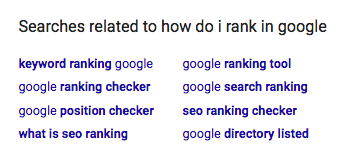
In the example above, the related searches show us that people are also asking “…” and “….” about the same topic. By including answers or mentions to these as well we can help to show Google that our piece of content is incredibly relevant and useful.
-
People Also Ask Box
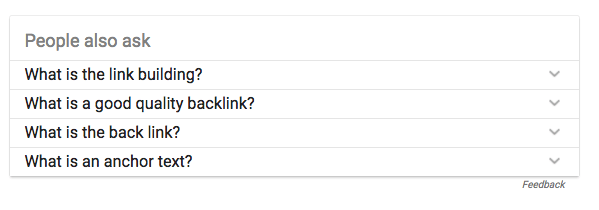
This box doesn’t appear for every single search term. It seems to be a newer feature that they’re testing out. But, if this box does appear in the search results for your intended search term, then you can bet it’s important.This is effectively Google telling you to pay attention. These are the questions that people want answers to when they’re searching for your chosen keyword.
All of these related search queries above will help to better frame your content as the right answer to all these questions. We all know that Google is consistently heading towards relevancy and searcher intent, so it’s a good idea to align your content in this direction as well.
Featured Snippet Optimization Overview
We know this post covered a lot and you might be a little overwhelmed with actually optimizing your site for Featured Snippets. Let the list below help you make a few simple optimization tweaks to increases your chances.
- Include your targeted search query within a header (h2, h3, etc)
- Place your targeted featured snippet within paragraph tags immediately following the header
- Include “Step 1”, “Step 2”, etc., if the answer demands it
- Begin your answer in a manner that logically follows the question
- For queries that don’t require a step-by-step answer the chances are high they’ll pull a paragraph instead, so make sure your content caters to this
Optimizing your content for Featured Snippet placement might seem like a lot of additional work. However, the increased traffic and top search engine placement you’ll receive will be well-worth the effort.
Plus, even the simple act of optimizing your content for Featured Snippets you’ll be improving things like the readability of your content and engagement metrics. Both of these will help to improve the overall quality of your site.
So, even if you fail to get placement you’re giving your readers a much better experience all around.
Now over to you. Do you have any key Featured Snippet optimization tips you’d like to share?




